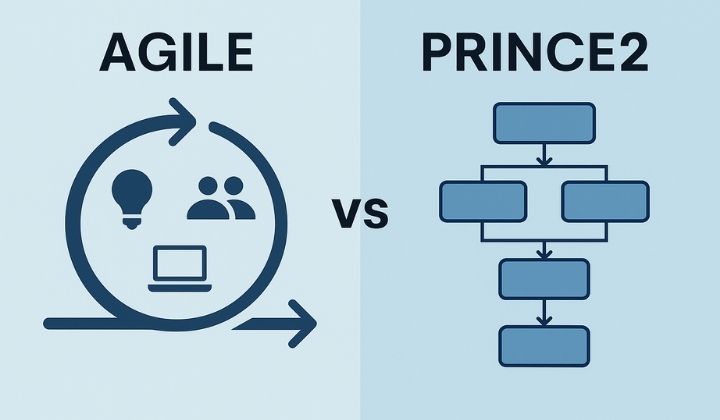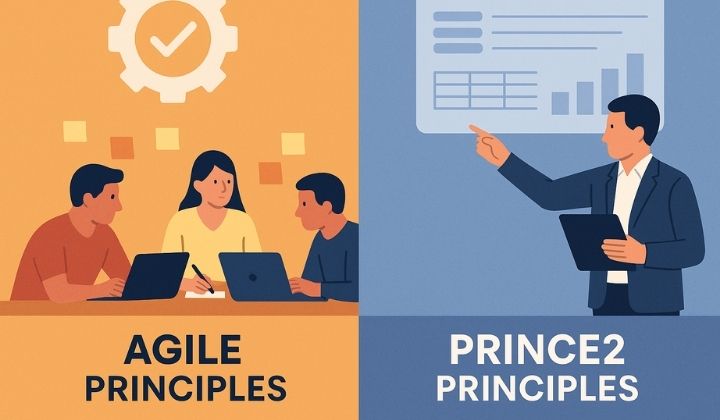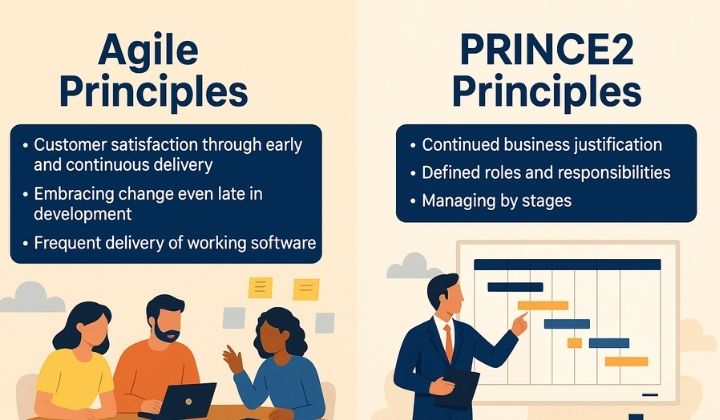
When you compare project management approaches, you might struggle to choose between Agile and PRINCE2. These two frameworks serve different purposes and have unique characteristics.
PRINCE2 is a structured methodology that focuses on processes and documentation. Agile is a flexible philosophy that emphasises adaptive planning and continuous improvement.

The differences go beyond definitions. PRINCE2 takes a predictive approach with detailed planning, making it suitable for projects with clear requirements.
Agile thrives on short-term planning and iterative development. This makes it perfect for projects where requirements might change.
Many organisations now combine PRINCE2’s governance with Agile’s flexibility. This hybrid approach lets you maintain structure while adapting to changing project needs.

Project management approaches vary widely. Agile and PRINCE2 represent two distinct methodologies that organisations choose based on their needs and project environments.
These frameworks differ in their principles, structures and applications.
Agile is an iterative approach to project management. It emphasises flexibility, collaboration and customer feedback.
Agile started in software development but now appears in many industries.
Core Agile principles include:
Agile uses frameworks like Scrum, Kanban and XP (Extreme Programming). Teams work in short sprints of 1-4 weeks, delivering functional components at each interval.
Agile focuses on lower-level teams and is especially useful for suppliers delivering working software. It values responding to change over following a rigid plan.
You’ll find Agile effective when requirements might evolve or when you need continuous delivery of value to customers.
PRINCE2 (PRojects IN Controlled Environments) is a structured project management methodology. It emphasises organisation, control and regular progress reviews.
It provides a systematic approach to project delivery.
PRINCE2 is built around:
PRINCE2 is the world’s most widely used project management methodology, with over 100,000 exams taken annually worldwide.
You’ll benefit from PRINCE2 if your project needs clear documentation, defined roles and strong governance. It’s especially useful when you must justify a project to stakeholders and keep tight control over resources.
PRINCE2 originated in the UK government sector. It started as PROMPT II in 1989, then became PRINCE and later PRINCE2 in 1996.
The UK government’s Office of Government Commerce developed it. PRINCE2 has had major updates in 2009 and 2017 to stay relevant.
Agile’s formal beginnings date to 2001 with the Agile Manifesto. Its roots go back to iterative and incremental development practices from the 1950s and 1960s.
The two methodologies evolved separately until PRINCE2 Agile was introduced to combine PRINCE2’s governance with Agile’s flexibility. This hybrid approach lets you keep control whilst embracing Agile’s adaptive nature.

PRINCE2 and Agile each have guiding principles that shape how you manage and deliver projects. These elements reflect different ways to achieve project success.
Agile is built around adaptability and collaboration. It focuses on delivering value early and often.
At its core, Agile prioritises:
The Agile mindset values individuals and interactions over processes and tools. It emphasises working solutions over comprehensive documentation.
Agile teams operate with high autonomy. They self-organise and regularly reflect on how to become more effective.
This approach helps you respond quickly to changing requirements and market conditions.
PRINCE2 provides a structured methodology focused on control and governance. Its seven core principles include:
PRINCE2 is a method rather than a philosophy. It offers you comprehensive documentation and clear project phases.
You’ll benefit from PRINCE2’s governance framework when you need high levels of control and compliance. The approach gives you predictability through detailed planning and defined management stages.
Understanding the differences between these methodologies helps you choose the right approach for your projects. Each framework offers advantages in structure, documentation, and stakeholder engagement.
PRINCE2 uses a structured, top-down approach with clear roles and responsibilities. It evaluates projects from a strategic perspective and focuses on higher management levels.
PRINCE2 divides projects into manageable stages with defined start and end points. Each stage needs formal approval before moving forward, creating a controlled environment.
Agile uses a flexible, bottom-up approach. It organises work into short iterations or sprints, usually lasting 2-4 weeks.
Agile teams are self-organising with less hierarchy. The framework focuses on team collaboration rather than strict governance.
Governance Comparison:
| PRINCE2 | Agile |
|---|---|
| Formal board structure | Self-organising teams |
| Defined management stages | Iterative sprints |
| Clear escalation paths | Flat hierarchy |
| Change control boards | Adaptive planning |
PRINCE2 values comprehensive documentation with detailed plans at the start. You’ll produce formal documents like project initiation documents, stage plans and exception reports.
This method values thorough planning and requires change requests to go through approval processes.
Agile prioritises working software over documentation. You’ll create just enough documentation to move forward, focusing on user stories and product backlogs.
Agile welcomes change even late in development. Your team can adjust priorities between iterations based on feedback.
Key documentation differences:
In PRINCE2 projects, stakeholder engagement follows a structured pattern with formal communication channels. Your project board includes key decision-makers who review progress at stage boundaries.
Communication usually flows through the project manager. Stakeholders mainly influence the project at key decision points.
Agile promotes continuous collaboration between stakeholders and development teams. You’ll have regular stakeholder involvement throughout the project.
Daily stand-ups, sprint reviews and demonstrations give stakeholders frequent chances to provide feedback. This ensures your product evolves with ongoing stakeholder input.
Customer representatives often work directly with development teams, sometimes as dedicated product owners who set priorities and represent user interests.
Both Agile and PRINCE2 bring benefits and face challenges in project delivery. Understanding these can help you choose the right approach for your organisation.
Agile excels at adaptability and quick response to change. Your team can adjust quickly to shifting requirements without major replanning.
Customer satisfaction is often higher with Agile because it focuses on continuous delivery of working products. Stakeholders see progress regularly through iterative cycles.
Agile encourages strong team collaboration and self-organisation. Team members take ownership of their work, which can lead to higher morale and productivity.
Agile manages risk continuously, allowing you to spot and address issues early.
Key Agile Benefits:
PRINCE2 provides strong structure and governance for complex projects. The structured approach ensures clear roles and responsibilities, making it easier to manage large teams and stakeholders.
Documentation and accountability are key advantages. Your project will benefit from detailed records that create a clear audit trail for future use.
PRINCE2 manages resources efficiently. Budget control and resource allocation are systematic, reducing the risk of cost overruns.
The stage-gate approach allows for controlled progression. Your project moves forward only when it meets set criteria, ensuring quality at each step.
PRINCE2 Strengths:
Agile can be tough to scale in large organisations. You might find coordination across multiple teams and integration with traditional corporate structures challenging.
The lack of detailed long-term planning in Agile creates uncertainty for some stakeholders. It can be hard to provide concrete timelines for project completion.
For PRINCE2, the need for extensive documentation often leads to bureaucracy. Your team might spend too much time on paperwork instead of delivering value.
PRINCE2 can also respond slowly to change. When requirements shift, you must go through formal change control procedures, which can slow progress.
Implementation Challenges:
| Agile Challenges | PRINCE2 Challenges |
|---|---|
| Resistance to cultural change | Overly rigid processes |
| Difficulty with fixed contracts | Training requirements |
| Stakeholder availability | Less suitable for creative work |
| Measuring progress objectively | Potential for document overload |
Choosing the right project management approach depends on your project’s nature, stakeholders, and organisational environment. Each methodology offers unique advantages in specific scenarios.
Agile works well for projects with evolving requirements and where customer feedback matters. Software development projects often benefit from Agile, as they need frequent adjustments based on user testing and market changes.
Projects with uncertain deliverables or a focus on innovation thrive with Agile. When you need to deliver value incrementally and show regular progress, Agile’s sprint-based approach lets you demonstrate working products at set intervals.
Agile is especially effective for:
Small to medium teams that communicate frequently and collaborate closely find Agile’s principles most effective.
PRINCE2 excels where strict governance, clear documentation, and defined accountability are required. Consider PRINCE2 when your project has fixed requirements, a clear end goal, and regulatory compliance needs.
PRINCE2’s structured governance helps when project boards need to make decisions about resources and funding. It’s ideal for projects with:
PRINCE2 provides a clear structure with pre-defined roles and stages. This makes it suitable for large, complex projects where accountability is crucial.
Different industries benefit from each methodology based on their needs and constraints.
Construction and Infrastructure: PRINCE2 works better due to fixed requirements, regulatory compliance, and step-by-step dependencies.
Technology and Software: Agile dominates here, allowing rapid prototyping and adaptation to changing technology.
Public Sector: PRINCE2 is common for its documentation and accountability. For example, a public sector team delivering a grant scheme might use PRINCE2 to manage budgets and compliance.
Education: Universities rolling out new systems often use hybrid approaches. When implementing a student management system, they can blend PRINCE2’s governance with Agile sprints to pilot features in stages.
Manufacturing often uses PRINCE2 for plant development but may adopt Agile techniques for production optimisation.
Combining Agile and PRINCE2 creates a framework that balances structure and flexibility. Many organisations find this mix invaluable for modern project delivery.
PRINCE2 Agile is the official hybrid framework that brings Agile delivery methods into the PRINCE2 governance structure. This approach keeps PRINCE2’s strong project management principles while embracing Agile’s iterative development and customer focus.
Other hybrid approaches include:
These hybrids let you choose the best elements based on your organisation’s culture, project needs, and team skills. The key is to keep governance and delivery practices in sync.
Combining these methodologies gives you several advantages:
Organisations using combined frameworks often report higher project success rates, especially for complex projects with changing requirements.
This integration also helps bridge communication gaps between traditional project managers and technical teams.
When you implement a hybrid approach, focus on a few key factors.
Cultural alignment is crucial—everyone needs to understand and respect both methodologies. Training should cover the principles of each and how they work together.
Selective application works best. Choose which elements of each method add value to your project.
Consider these steps:
Avoid over-documentation or rigid processes that can undermine Agile’s responsiveness. Aim for a balance that gives you structure without losing agility.
Both Agile and PRINCE2 offer strong certification pathways. These credentials boost your project management career and help you deliver successful projects.
Agile certification offers several routes depending on your career goals and interests. The Agile approach focuses on efficient product delivery and adaptability.
Popular Agile certifications include:
Training usually lasts 2-3 days, and some certifications need practical experience. Most Agile certifications require renewal every 1-3 years through ongoing learning or exams.
PRINCE2 offers a structured path to build expertise in controlled project environments. PRINCE2 training covers key project management elements with clear progression.
PRINCE2 certification levels:
Foundation courses usually last 2-3 days with a final exam. Practitioner courses add another 2 days. PRINCE2 Practitioner certification lasts three years, after which you need to re-register or collect CPD points.
Both methodologies offer strong career opportunities but suit different industries. PRINCE2 gives you structure, while Agile offers flexibility.
Your choice might depend on:
Many professionals hold both certifications. This lets you apply the right method for each project. Employers increasingly value people who can blend methods for the best results.
Project managers often want clarity on the differences between methodologies and how to use them. Here are answers to common questions about PRINCE2 and Agile, their integration, and use cases.
PRINCE2 is a structured, process-based method that focuses on higher-level management, clear documentation, and defined stages. It gives you a full framework for managing projects from start to finish.
Agile is adaptive, emphasising flexibility and iterative development. It aims to deliver working products quickly and respond to change, rather than sticking to a rigid plan.
Scrum is a framework within Agile. It uses short cycles called sprints, daily stand-ups, and roles like Scrum Master and Product Owner. Some people mistakenly call PRINCE2 Agile “Scrum,” but they’re different approaches.
Agile is naturally flexible, letting teams adapt quickly to changes. You don’t plan the whole project upfront; instead, you work in iterations, gather feedback, and adjust as needed.
PRINCE2 is more predictive, with detailed planning at the start. But it’s a myth that PRINCE2 can’t handle changes. Its stage-based approach allows for controlled adjustments at stage boundaries.
The main difference is in how and when you make changes. Agile welcomes changes at any point, while PRINCE2 manages them through formal controls to keep governance in place.
PRINCE2 Agile certification has become highly valuable, especially for organisations looking for both governance and flexibility. Many PRINCE2 practitioners wanted more knowledge about Agile approaches.
Traditional PRINCE2 certification still holds strong value for complex projects that need strict governance. PRINCE2 Agile often suits workplaces where you need both control and adaptability.
Your choice depends on your industry and the types of projects you manage. Many professionals choose to get both certifications to show their versatility.
PRINCE2 works best for large, complex projects with fixed budgets and clear requirements. It’s especially helpful when you need to justify a project from the customer’s perspective and when strong governance matters.
Agile fits environments where requirements may change and fast delivery is important. It works well when customers can collaborate closely and suppliers need to deliver working software in stages.
Projects with lots of uncertainty benefit from Agile’s iterative style. Projects with strict compliance needs often require PRINCE2’s controls and governance.
Combining PRINCE2 with Agile gives you strong governance and the flexibility to respond to change. This mix helps you keep management oversight while delivering quickly.
Organisations often use PRINCE2 for overall project governance, stage planning, and risk management. They then apply Agile methods for delivering products within those stages.
Teams might work in sprints and report progress to a PRINCE2 project board. Many organisations keep PRINCE2 documentation but make it lighter to match Agile’s focus on working products.
PRINCE2 Agile stands out as the main official framework that combines these methodologies. AXELOS, who own PRINCE2, developed it to give clear guidance on using Agile methods within the PRINCE2 structure.
AgilePM (Agile Project Management) takes a different approach. It blends Agile with DSDM (Dynamic Systems Development Method) and brings in some project management principles similar to PRINCE2.
Some organisations develop their own frameworks by picking elements from both methodologies. They do this to suit their specific needs.
See your entire business at a glance
Get a clear, all-in-one view of your entire business, so you can stay on top of everything that matters. Whether you're juggling multiple projects or just need a better way to stay organised, our platform gives you the visibility you need, fast.
Instant setup. No payment details needed.